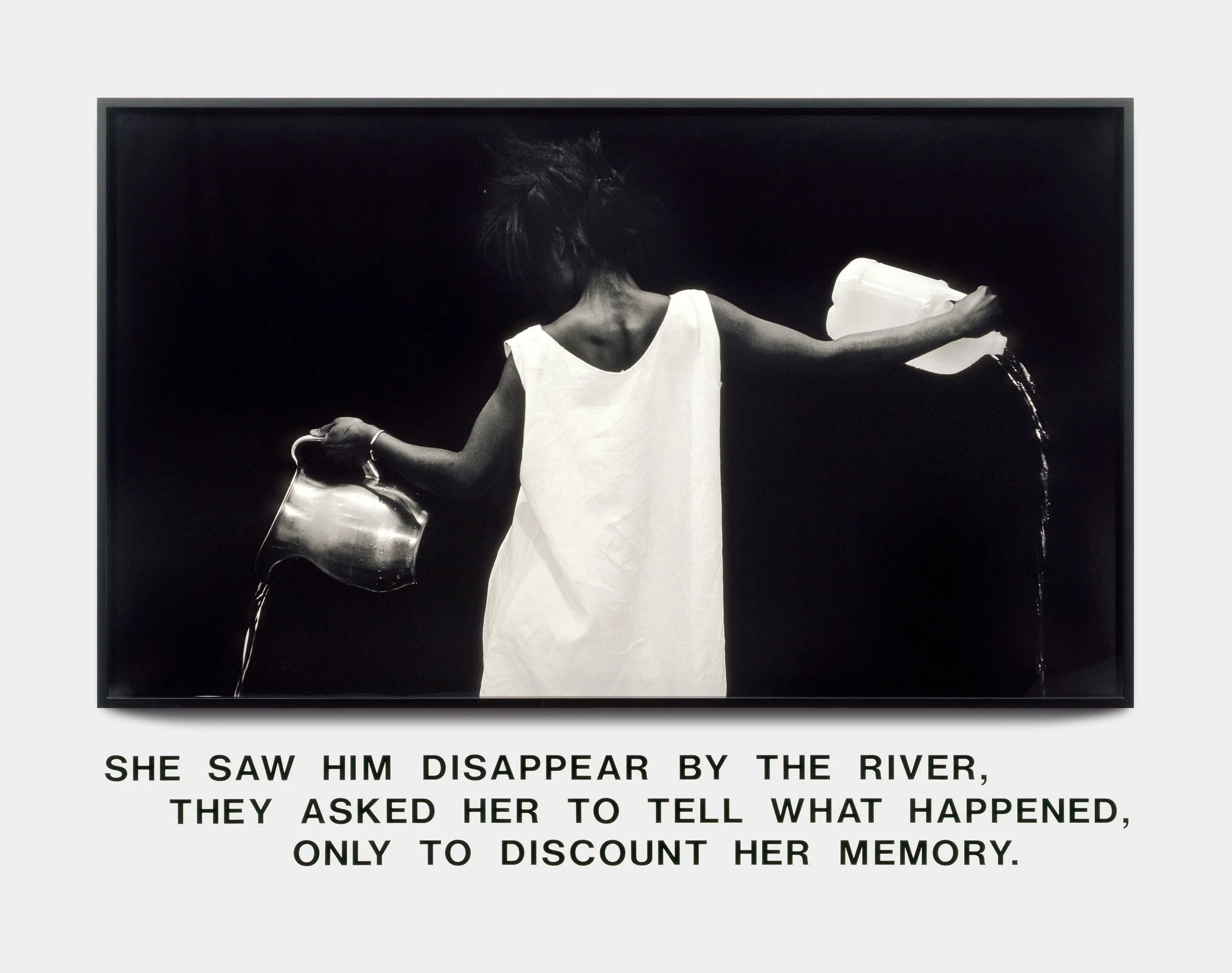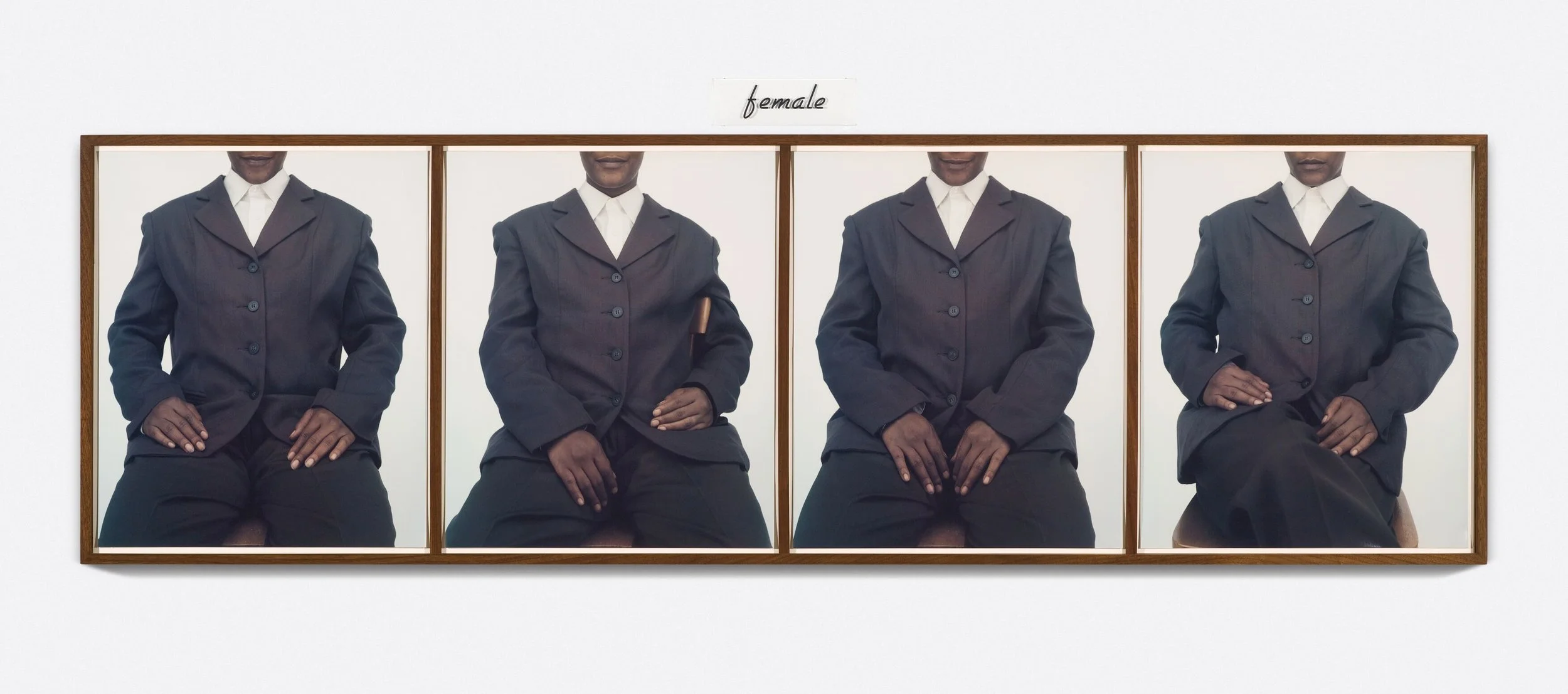Exhibition Review: Lorna Simpson 1985 – 92
Waterbearer
1986
Silver gelatin print, vinyl lettering
Ed. of 1 + 1 AP
Overall: 149.9 x 203.2 x 5.7 cm / 59 x 80 x 2 1/2 in
© Lorna Simpson
Courtesy the artist and Hauser & Wirth
Collection of Kit Howard
Written by Margarita Matta
Copyedited by Chloë Rain
When looking at conceptual photography, Lorna Simpson is at the forefront of this movement, combining multimedia art and photography to create a much richer, layered approach to her bodies of work. When combining multiple forms of art to create a complex vessel of communication, it creates a completely different perspective than we would get solely by looking at photography or multimedia collage. Simpson not only does this in a visually compelling, knowledgeable manner, but is a trailblazer in her work. As the gallery website says, Simpson was the first female artist in American art to engage in conceptual work that not only addressed the vast history of African American suppression and enslavement, but also the artistic, cinematic, and political consciousness through questions of race and gender. Simpson combines the here and now, the history and consequences.
You're Fine
1988
4 dye diffusion color Polaroid prints, 15 engraved plastic plaques, ceramic letters
Unique
Overall: 99.1 x 274.6 x 4.1 cm / 39 x 108 1/8 x 1 5/8 in
© Lorna Simpson
Courtesy the artist and Hauser & Wirth
Private Collection
Simpson’s signature style uses documentary-esque photographic works accompanied or juxtaposed by fragments of text, creating a larger meaning that pushes us to question and probe why this body of work makes us feel a certain way. Simpson’s Waterbearer shows a girl with her back to the camera, pouring a silver vase of water with one hand and a plastic jug with the other. The text beneath this image reads “SHE SAW HIM DISAPPEAR BY THE RIVER, THEY ASKED HER TO TELL WHAT HAPPENED, ONLY TO DISCOUNT HER MEMORY.” There is a large juxtaposition seen between the two vessels of water, the vase representing a wealthier body, the plastic jug a poorer one. One can interperate that this represents the vast wealth gap between races in America, created by the gruesome history of slavery and prejudice faced by African Americans. The text accompanying this image should not be overlooked, as it plays another key role in expressing the prejudice faced in black America. It speaks to the mistrust so much of America has towards African Americans, a stigma fueled by race and bigotry. Especially towards black women, such as the one photographed in this work, speculation is another form of oppression faced far too often. This work allows for questions of identity and history to be raised, while also taking into account the role of race and gender in prejudice.
1978-1988
1991
4 silver gelatin prints, 13 engraved plastic plaques
Ed. of 4 + 2 AP
Overall: 123.8 x 171.5 x 4.1 cm / 48 3/4 x 67 1/2 x 1 5/8 in
© Lorna Simpson
Courtesy the artist and Hauser & Wirth
Photo: James Wang
Coiffure
1991
3 silver gelatin prints, 10 engraved plastic plaques
Ed. of 3 + 2 AP
Overall: 184.2 x 269.2 x 4.8 cm / 72 1/2 x 106 x 1 7/8 in
© Lorna Simpson
Courtesy the artist and Hauser & Wirth
Collection of Michael Krichman and Carmen Cuenca
Another important aspect to Simpson’s work is the concept and use of hair as a vehicle for expressing and understanding black culture, notably in her works 1978-1988 and Coiffure. The practices, effort, and various ways in which black women and hair are intertwined in their culture help to express a larger image of what it means to be African American, both when these works were created and today. How do we use hair as a vehicle for stereotyping? How can we use more practical, day to day activities and entities such as hair to experience and appreciate culture? These works help to remind the viewer that every cultural entity is a two sided coin, and can be used for either prejudice or understanding. Simpson pushes us to use it for the latter, and wants us to question and regard the many preconceptions surrounding them.
She
1992
4 dye diffusion color Polaroid prints, 1 engraved plastic plaque
Ed. of 4
Overall: 73.3 x 216.2 x 5.1 cm / 28 7/8 x 85 1/8 x 2 in
© Lorna Simpson
Courtesy the artist and Hauser & Wirth
Collection of Jack and Sandra Guthman
Photo: Nathan Keay
Lorna Simpson 1985-92 will be on display at Hauser & Wirth through October 22, 2022 located on 69th street in New York, New York. The exhibition will occupy all three floors of the gallery.












